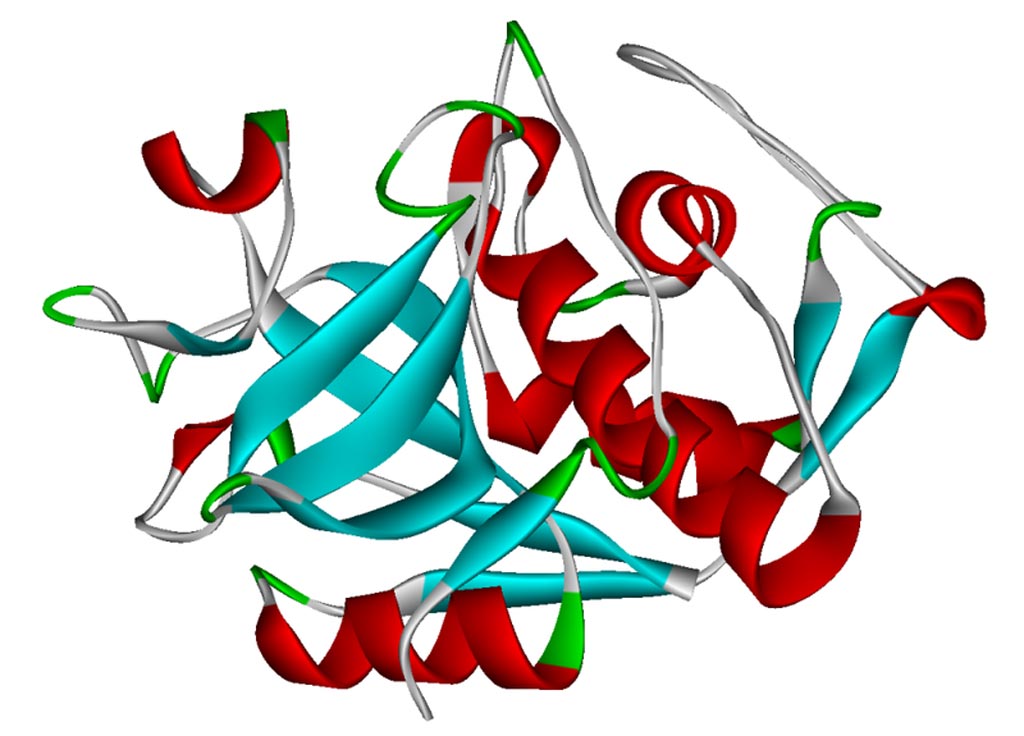Bone Peptide Measurement Predicts Fracture Risk
By LabMedica International staff writers
Posted on 28 Aug 2017
Measurement of the peptide fragment that results from in vivo digestion of the periostin protein by the enzyme cathepsin K in blood samples identifies subjects at high risk of bone fracture.Posted on 28 Aug 2017
Periostin is a matricellular protein involved in bone formation and bone matrix organization, but it is also produced by other tissues. Its circulating levels have been weakly associated with bone microstructure and prevalent fractures, possibly because periostin measured by the current commercial assays does not specifically reflect bone metabolism.

Image: A ribbon diagram of human cathepsin K, colored by secondary structure (Photo courtesy of Wikimedia Commons).
To improve this situation, investigators at the University of Geneva (Switzerland) developed a new ELISA to measure in blood samples the concentration of the periostin fragment (K-Postn) that results from cathepsin K digestion. Cathepsin K is a protease involved in bone resorption. The enzyme's ability to catabolize elastin, collagen, and gelatin allow it to break down bone and cartilage. The investigators hypothesized that circulating K-Postn levels could be associated with bone fragility.
To test this theory, a total of 695 women (age 65.0 ± 1.5 years), enrolled in the Geneva Retirees Cohort (GERICO), were prospectively evaluated over a period of about five years for the occurrence of low-trauma fractures. The investigators measured serum periostin, K-Postn, and bone turnover markers (BTMs), distal radius and tibia microstructure by HR-pQCT (High Resolution Peripheral Quantitative Computer Tomography), hip and lumbar spine BMD (bone mineral density) by DXA (Dual-energy X-ray absorptiometry), and estimated fracture probability using the Fracture Risk Assessment Tool (FRAX).
Results revealed that 66 women sustained a low-trauma clinical fracture during the follow-up period. Total periostin was not associated with fractures; while in contrast, K-Postn was significantly higher in the fracture versus nonfracture group and associated with fracture risk. After adjustment for BMD, FRAX, bone microstructure, or BTMs, K-Postn remained significantly associated with fracture risk. Furthermore, the performance of the fracture prediction models was improved by adding K-Postn to BMD or FRAX.
Circulating K-Postn predicted risk of fracture independently of BMD, BTMs, and FRAX in postmenopausal women. Therefore, measurement of a periostin fragment resulting from in vivo cathepsin K digestion may help to identify subjects at high risk of fracture.
"The periostin fragments' strong association with incident fractures is largely independent of other bone measures, arguing that they may reflect additional bone properties related to bone quality and strength," said first author Dr. Nicolas Bonnet, a researcher in cell biology at the University of Geneva.
The study was published in the August 2, 2017, online edition of the Journal of Bone and Mineral Research.
Related Links:
University of Geneva









 Analyzer.jpg)



